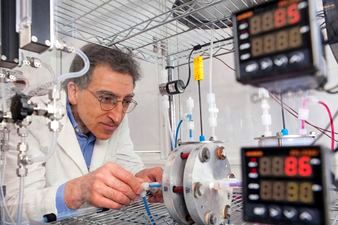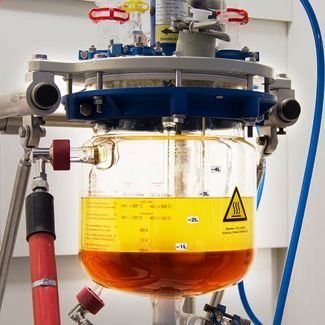
A team of Harvard scientists and engineers has demonstrated a new type of battery that could fundamentally transform the way electricity is stored on the grid, making power from renewable energy sources such as wind and sun far more economical and reliable.
The novel battery technology is reported in a paper published in Nature on January 9. Under the OPEN 2012 program, the Harvard team received funding from the U.S. Department of Energy’s Advanced Research Projects Agency – Energy (ARPA-E) to develop the grid-scale battery, and plans to work with the agency to catalyze further technological and market breakthroughs over the next several years.
The paper describes a metal-free flow battery that relies on the electrochemistry of naturally abundant, inexpensive, small organic (carbon-based) molecules called quinones, which are similar to molecules that store energy in plants and animals.
The mis-match between the availability of intermittent wind or sunshine and the variable demand is the biggest obstacle to using renewable energy sources for a large fraction of our electricity. A cost-effective means of storing large amounts of electrical energy could solve this problem.
The battery was designed, built, and tested in the laboratory of Michael J. Aziz, the Gene and Tracy Sykes Professor of Materials and Energy Technologies at the Harvard School of Engineering and Applied Sciences (SEAS). Roy G. Gordon, the Thomas Dudley Cabot Professor of Chemistry and Professor of Materials Science, led the work on the synthesis and chemical screening of molecules. Alán Aspuru-Guzik, professor of chemistry and chemical biology, used his pioneering high-throughput molecular screening methods to calculate the properties of more than 10,000 quinone molecules in search of the best candidates for the battery.
Flow batteries store energy in chemical fluids contained in external tanks, as with fuel cells, instead of within the battery container itself. The two main components – the electrochemical conversion hardware through which the fluids are flowed (which sets the peak power capacity) and the chemical storage tanks (which set the energy capacity) – may be independently sized. Thus, the amount of energy that can be stored is limited only by the size of the tanks. The design permits larger amounts of energy to be stored at lower cost than with traditional batteries.
By contrast, in solid-electrode batteries, such as those commonly found in cars and mobile devices, the power conversion hardware and energy capacity are packaged together in one unit and cannot be decoupled. Consequently, they maintain peak discharge power for less than an hour before they are drained, and are therefore ill-suited to store intermittent renewables.
“Our studies indicate that one to two days’ worth of storage is required for making solar and wind dispatchable through the electrical grid,” said Aziz.
To store 50 hours of energy from a 1-megawatt power capacity wind turbine (50 megawatt-hours), for example, a possible solution would be to buy traditional batteries with 50 megawatt-hours of energy storage, but they would come with 50 megawatts of power capacity. Paying for 50 megawatts of power capacity when only 1 megawatt is necessary makes little economic sense.
For this reason, a growing number of engineers have focused their attention on flow-battery technology. But until now, flow batteries have relied on chemicals that are expensive or hard to maintain, driving up the cost of storing energy.
The active components of electrolytes in most flow batteries have been metals. Vanadium is used in the most commercially advanced flow-battery technology now in development, but it sets a rather high floor on the cost per kilowatt-hour at any scale. Other flow batteries contain precious metal electrocatalysts, such as the platinum used in fuel cells.
The new flow battery developed by the Harvard team already performs as well as vanadium flow batteries, with chemicals that are significantly less expensive, and with no precious-metal electrocatalyst.
“The whole world of electricity storage has been using metal ions in various charge states, but there is a limited number that you can put into solution and use to store energy, and none of them can economically store massive amounts of renewable energy,” Gordon said. “With organic molecules, we introduce a vast new set of possibilities. Some of them will be terrible and some will be really good. With these quinones, we have the first ones that look really good.”
Aspuru-Guzik noted that the project is very well aligned with the White House Materials Genome Initiative. “This project illustrates what the synergy of high-throughput quantum chemistry and experimental insight can do,” he said. “In a very quick time period, our team homed in to the right molecule. Computational screening, together with experimentation, can lead to discovery of new materials in many application domains.”
Quinones are abundant in crude oil as well as in green plants. The molecule the Harvard team used in its first quinone-based flow battery is almost identical to one found in rhubarb. The quinones are dissolved in water, which prevents them from catching fire.


















